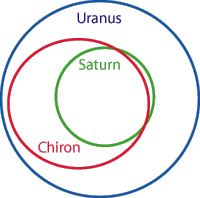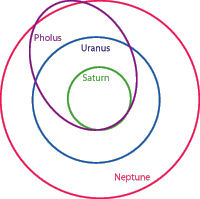
| What Watch? - Tutorial | Next chapter: Bibliography | Back to First Page |
FAQ 2 - The Planets
This FAQ provides a short overview of the meaning of the planets available for calculations in What Watch. To keep it simple, I just talk about "planets" here – but in astronomical terms, it's more complicated. There are only eight planets in their proper sense in the Solar system:
The Sun itself, in the center of the system, is no planet in astronomical terms. The same applies to the Moon. Pluto is not a planet neither, even if it was classified as such for a couple of decades. Pluto belongs to the Kuiper belt, a realm beyond Neptune where many small bodies circle the Sun. Pluto is big enough, however, to be called a "dwarf planet" (there are dwarf planets in each class of bodies: they are heavy enough to take a round shape).
Many of these small objects have only been discovered in recent years. Astronomers are currently classifying these objects – and many classifications are still preliminary. Astrologers now ask the question which of these many bodies to interpret. To interpret them all is impossible. Is it meaningful to interpret the biggest of its class? Or the first one discovered? Or other ones, using which criteria?
The most important classes next to the planets are:
And there are some very distant bodies that probably do not belong to the Kuiper belt, but relate to a group even farther beyond: the Oort cloud. Most prominent member so far is Sedna.
In astrology, there are some points in the chart that do not represent celestial bodies, but are derived from the orbits of other objects, such as Lilith and the Moon's nodes.
The astrological meaning of the different "planets" is explained in the following. And you'll find additional information on some of the newly discovered dwarf planets.
Sun
Catchword: The power of being oneself
Natural house: 5
Domicile: Leo, Exaltation: Aries, Fall: Libra, Detriment: Aquarius
Moon
Catchword: The power of emotion
Natural house: 4
Domicile: Cancer, Exaltation: Taurus, Fall: Scorpio, Detriment: Capricorn
Mercury
Catchword: The power of communication
Natural houses: 3 and 6
Domicile: Gemini / Virgo, Exaltation: Aquarius, Fall: Leo, Detriment: Sagittarius
/ Pisces
See also Ceres for Virgo and House 6.
Venus
Catchword: The power of love and connection
Natural houses: 2 and 7
Domicile: Taurus / Libra, Exaltation: Pisces, Fall: Virgo, Detriment: Scorpio
/ Aries
Mars
Catchword: The power of life's energy
Natural houses: 1 and 8
Domicile: Aries / Scorpio, Exaltation: Capricorn, Fall: Cancer, Detriment: Libra
/ Taurus
See also Pluto for Scorpio and House 8.
Ceres
Catchword: The power of living nature
Natural house: 6 (?)
Domicile: Virgo (?)
Ceres is the largest object in the asteroid belt and was discovered in 1801. Its astrological significance is widely disputed. Most astrologers see it as a minor energy. But there is some astronomical evidence that Ceres is in fact a planet that never fully grew up - all the other lumps of the asteroid belt never completely assembled into the missing planet that for various reasons might be expected between Mars and Jupiter. Ceres has more than half of the asteroid belt's mass and was classified as a "dwarf planet" in 2006. So there's still ample room for astrological research.
Jupiter
Catchword: The power of expansion and faith
Natural houses: 9 and 12
Domicile: Sagittarius / Pisces, Exaltation: Cancer, Fall: Capricorn, Detriment:
Gemini / Virgo
See also Neptune for Pisces and House 12.
Saturn
Catchword: The power of time and structure
Natural houses: 10 and 11
Domicile: Capricorn / Aquarius, Exaltation: Libra, Fall: Aries, Detriment: Cancer
/ Leo
See also Uranus for Aquarius and House 11.
Uranus
Catchword: The power of imagination and the ideal
Natural house: 11
Domicile: Aquarius, Exaltation: Scorpio, Fall: Taurus, Detriment: Leo
Uranus was discovered in 1781. It needs 84 years to travel once around the Sun.
Neptune
Catchword: The power of redemption and the primal waters
Natural house: 12
Domicile: Pisces, Exaltation: Cancer, Fall: Capricorn, Detriment: Virgo
Neptune was discovered in 1846. It needs 165 years to travel once around the Sun.
Pluto
Catchword: The power of transformation
Natural house: 8
Domicile: Scorpio, Exaltation: Aquarius, Fall: Leo, Detriment: Taurus
When Pluto was discovered in 1930, there was complete ignorance of anything beyond Neptune. Kuiper belt, Oort cloud, centaurs - never heard of. So, even if Pluto was very small compared to Neptune or Uranus, it was declared a planet. Today, there is ample evidence that this classification was an error. Pluto was reclassified as a "dwarf planet" in 2006, and it's a Kuiper belt object. It needs 248 years to travel once around the sun.
In astrology, this teaches us that a celestial body doesn't need to be a planet to be influential. Pluto's significance is beyond doubt, and its transits belong to the heaviest that exist.
He dances and sings first 'Weywot' who becomes Sky Father; they sing and dance 'Chehooit' Earth Mother into existence. The trio sing 'Tamit' Grandfather Sun to life. As each divine one joins the singing and dancing, the song becomes more complex and the dance more complicated. In turn 'Moar', Grandmother Moon (a very complex diety), 'Pamit' the Goddess of the sea, 'Manit', the Lord of dreams and visions, 'Manisar' the bringer of food and harvests, 'Tukupar Itar' Sky Coyote (who is also our major hero), 'Tolmalok', the Goddess of Shishongna (the underworld) join in the singing, dancing and creating. And finally the great seven giants who hold up the worlds are created. The High Ones in turn are aided by 'Eagle, Duck, Bear, and Frog' in a grand earth diving story. Frog brings up soil out of the deep dark sea, and the four animals dance it flat and wide. The 'Gods and Goddesses' then furnish the world 'Tovangar' with hills, mountains, trees, rivers, etc. 'Tobohar' (first man) and 'Pahavit' (first woman) are also part of this great 'Creation song and dance cycle'."
Sedna
Catchword (my suggestion): The nurturing force of the unconscious
|
Sedna is an extreme celestial body. She's farther away from the Sun than any other known object in the solar system. It takes 10.500 years for her to travel once around the Sun. You can see her orbit on the right, the small circles are the orbits of Pluto, Neptune, Uranus and Saturn. |
 |
At the moment, Sedna is relatively close to the Sun and moves relatively fast: Sedna entered Taurus between 1965 and 1968 and is bound to leave in 2023/24. Sedna is probably the first object observed that belongs to the Oort cloud, whose existence was a mere theoretical assumption up to now. Sedna was discovered on 14 november 2003.
Sedna is named after a goddess of the Sea and the Underworld. She's one of the central gods of the Inuit, the native inhabitants of the arctic coast of America: she decides about the amount of fish, seal or whale to be found by the Inuit in the sea, their only source of food. If she is angry, a shaman has to dive down to her depths and comb her braids.
Before her life in the depths, Sedna was a young girl that lived on the surface. Her parents, in some versions her widowed father, when trying to escape from wild birds, threw her overboard into the depths of the sea. In most detailled versions, it is a very cruel story. But the background is always the same: the failure to separate from the parents leads to a difficult passage that in the end opens up a new life.
|
Chiron Catchword: The power of wounds and healing Chiron was the first of a new group to be discovered: the centaurs. These messengers between our personal conscious world and the collective unconscious are of prime importance for us modern beings. They help to extend consciousness to the realm beyond Saturn, to avoid just flowing with the collective stream of energy. Astronomically, Chiron moves between Saturn and Uranus. It was discovered in 1977. |
 |
|
Pholus Catchword: The power of incarnation The second of the centaurs, Pholus brings us consciously to Neptune, to the primal waters of all live and mankind. Saturn is afraid of them, afraid of losing one's identity, that precarious thing represented by the inner planets. Pholus makes us courageous and finds ways of bypassing the angst, of starting what is already inside, of bringing one's essence into flesh. Astronomically, Pholus moves between Saturn and Neptune. It was discovered in 1992. |
 |
Nessus
The 3rd centaur was discovered in 1993. As its orbit goes far beyond Neptune, it was thought to be a link between Saturn and Pluto. But since the discovery of Quaoar in 2002, a link between Saturn and this newly found Kuiper belt object is also possible.
Asbolus
Asbolus, the seer and magician, travels from far away in the unconscious to enter the conscious mind as deeply as almost no other of his kind. This centaur, discovered in 1995, almost reaches Jupiter. There is not much astrological experience with Asbolus, but its far reach from Neptune to Jupiter makes it one of the promising candidates for future research.
The Moon's Node
Originating in Indian astrology, the Moon's nodes have to be analysed against a karmic background. The southern node signifies karmic "ballast", the remainders of incarnations past. It's the polar opposite, the north node, that allows to dissolve these energies.
What Watch uses the true node, with one exception: due to limitations in the computing routines, the transiting node is always the mean one. Please keep in mind when looking at the dates that transiting true and mean node may be a couple of days apart.
Lilith (Black Moon, The Moon's Apogee)
Catchword: The power of letting go
The Black Moon is commonly regarded as the point in the moon's orbit that is farthest away from the earth (astronomically called "apogee"). The problem is that the moon's motion is highly irregular due to the sun's gravitational influences. That's why it's impossible to precisely calculate the moon's apogee except for the few moments where the moon is actually at this place. In all other moments, Lilith's position is merely theoretical.
There are a couple of ways of dealing with this. The mean apogee ignores all this and pretends the moon to move on a smooth elliptical orbit. The interpolated apogee, however, compensates for all this in a mathematical way, interpolating between actual apogee data as it was astronomically observed.
What Watch offers the mean and interpolated apogees for natal charts. Transit lists are available for the mean apogee only.
Progressed Sun
Catchword: Individuation
Progressed Moon
Catchword: Emotional life cycles
| What Watch? - Tutorial | Next chapter: Bibliography | Back to First Page |